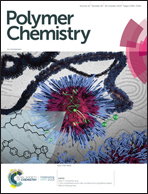Muconic acid esters as bio-based acrylate mimics†
Abstract
Over the course of the last century, a large number of synthetic polymers has been developed and introduced. Yet, most polymer materials are based on fossil fuels as raw materials and are associated with a considerable environmental impact. trans,trans-Muconic acid esters are interesting plant-based monomers that have not received much attention yet. The synthesis of a series of dialkyl muconates from muconic acid is described, followed by an optimization of the solution free-radical polymerization of these monomers. Unlike the claim in previous studies, dialkyl muconates can be polymerized efficiently in solution to polymers with significant molecular weights above 105 g mol−1. Polymerizations are, however, relatively slow, as can be expected for diene monomers (48 h at 120 °C). Mark–Houwink coefficients have been determined for diethyl muconate, dibutyl muconate and di(2-ethylhexyl) muconate. Furthermore, glass transition temperatures and thermal stability are assessed for the polymers, showcasing that polymuconates can serve as alternatives to polyacrylate materials. In a last step, also the reversible addition–fragmentation chain transfer (RAFT) polymerization of the muconates is investigated, showing excellent control over the molecular weight when a conventional trithiocarbonate is used to control polymerizations.



 Please wait while we load your content...
Please wait while we load your content...